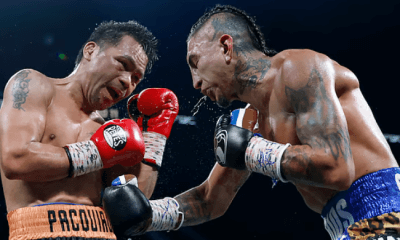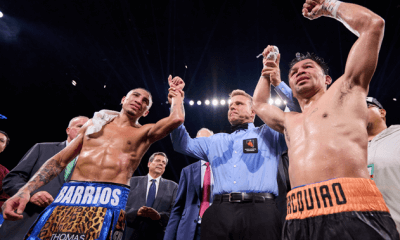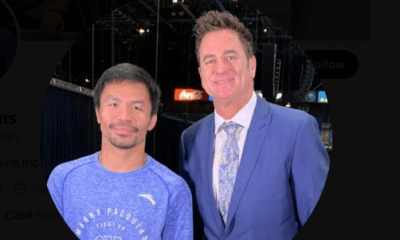Featured Articles
'Hurricane' Carter's Death Still Brings No Closure

“Based on a true story.”
Hollywood packages many of its biographical movies in such a manner, but my experiences in covering the controversial aftermath of a 1999 flick, The Hurricane, about the life and times of incarcerated former middleweight contender Rubin “Hurricane” Carter, taught me that separating truth from fiction is frequently a matter of individual perception. For whatever reason, most people choose to believe what they want to believe. Maybe that’s because human beings are prone to react subjectively, on the basis of their own personal emotions and biases, rather than on a dispassionate review of factual matters.
As Norman Jewison, director of The Hurricane, said after a lawsuit brought by former middleweight champion Joey Giardello, whose winning defense of his title in a Dec. 14, 1964, bout against Carter in Philadelphia was severely distorted in the film (and on this point there can be no doubt), observed after Giardello’s suit was settled out of court, “The truth is a moving target, I found. When you make a film about real people, about something that really happened, you’ll never get it right because there’s always somebody who’s going to disagree with you.”
The announcement of Carter’s death on Easter Sunday, at age 76 and after a long bout with prostate cancer, brought back a flood of memories of how difficult it sometimes is to pronounce anything as the incontrovertible truth, because, as Mr. Jewison correctly noted, truth is almost always slippery to pin down to everyone’s satisfaction. And that’s especially the case when the movie people decide to take what is or what was real and twist it, like a pile of Silly Putty, into a story line that fits a particular director’s or screenwriter’s agenda.
All the news stories I’ve read about Carter’s death state, unequivocally, that he was a black man wrongfully convicted of the murder of three white patrons of a Paterson, N.J., bar in 1966. That verdict, arrived at by an all-white jury, resulted in Carter spending 22 years behind bars. But is “not guilty” the equivalent of “innocent”? There are still people familiar with the case who insist that a judge’s eventual overturning of Carter’s conviction was based on procedural matters –namely, prosecutorial errors – rather than on evidentiary ones. The only way anyone can say with any degree of certainty that Rubin Carter was or wasn’t a murderer was to have been in that bar the night those three people were killed, in which case the observer either would have wound up as another corpse or, had he or she survived, could have testified that it was or wasn’t someone other than the boxer who pulled the trigger.
It is not my intention to speculate about the larger and more prevalent theme of The Hurricane, which is the senseless killing of three people and one man’s possibly unjust two-decades-plus spent behind bars in retribution for those deaths. But there is a key three-minute sequence in Jewison’s otherwise well-made, well-received film that casts a dark shadow about the authenticity of the entire finished product, and how that depiction played fast and loose with something indisputably true. That sequence deals with Carter’s bout with Giardello (whose real name was Carmine Tilelli), an honest workman who was inducted into the International Boxing Hall of Fame in 1991.
In the movie, Giardello is shown taking a horrific beating from Carter in the 15th and final round. After a delay in the tabulation of the judges’ scorecards, the champion is proclaimed the winner by unanimous decision, an announcement greeted with boos and catcalls from the audience in the Philadelphia Civic Center. An unnamed blow-by-blow commentator for the telecast is also aghast at the injustice perpetrated against the challenger.
“I’ve seen a lot of things in my time, but it’s taken 35 minutes to tell us what this hometown crowd (Giardello, a native of Brooklyn, N.Y., trained in South Philly and was a longtime resident of the Philadelphia suburb of Cherry Hill, N.J.) already knows,” Jewison’s fictionalized broadcaster says in the film. “Joey Giardello is about to lose the crown to Rubin `Hurricane’ Carter.
“They (the judges) must have been watching a different fight, because the one we just saw, Hurricane Carter took the title,” the broadcaster says after the decision angers spectators whose allegiance had shifted over the course of the bout from Giardello to Carter.
Full disclosure: My wife and I took Giardello, who was 78 when he died on Sept. 4, 2008, and his wife, Rosalie, to see The Hurricane the week of its release for the purpose of me writing about their reaction to the fight sequence in question.
“I can’t believe what I’m seeing,” Rosalie Tilelli, who attended the actual fight, said to her husband as the fight scene played on the wide screen. “They made it seem like he beat the hell out of you. I never thought it would be like this. I thought they would make it, you know, a little bit controversial. But this is ridiculous. It’s so unfair.”
Said Giardello: “They got the crowd booing me. How could they do that? Nobody booed. Those were my people there, from South Philly. They were happy I won. And I did win. I won, he lost. End of story.
“End of the fight, Carter congratulated me in the ring. He wasn’t complaining because he didn’t have anything to complain about. I was better than him. I know it, he knows it, everybody who was at the fight knows it. It’s just too bad all the people who see this movie won’t know it.”
Two people who knew what Giardello and his wife knew were Les Keiter, who called the fight for TV, and Ron Lipton, a New York-based referee who was a personal friend of Carter’s and had been asked by the moviemakers to do the choreography for the boxing sequences, a job he didn’t get because, he said, he refused to go along with Jewison’s instruction to portray the fight as a racially-motivated robbery.
It took me less than 10 minutes of calling around to track down Keiter, who was then living in Hawaii, for his take on how he – or the guy pretending to be him on-screen – was portrayed.
“The scene was absolutely, totally fictitious,” Keiter told me. “I never said any of that. Not even close.
“I have my call of the fight on tape. I played it for several of the sports writers here in Hawaii. Giardello, in my scoring, was the clear-cut winner. Now, it was a reasonably close fight. But the 15th round was just the reverse of what was shown. It was all Giardello, with his boxing and his counterpunching.”
Lipton has photos of himself with Muhammad Ali when they went to post bail for Carter in 1976. In an email he posted on the Cyber Boxing Zone message board after Carter’s death, he said “the photos of me standing with Carter with Ali speak for themselves.” It was Carter, in fact, who proposed to Jewison that his friend, Lipton, serve as the choreographer for the fight scenes for the movie.
So why didn’t Lipton get that gig, which would have paid him a nice chunk of money he admits he could have used? It was, he said, because he resisted the movie people’s suggestion to take liberties with what really happened that night.
“But Joey Giardello is still alive. It would hurt him to have the fight presented that way,” Lipton said he told the Hollywood people.
“No big deal. He’s just some old pug nobody cares about,” he said of the response he received.
When Giardello settled out of court – for a reported $350,000 – Lipton admitted to being happy that justice, to an extent, was served because, well, Lipton was a fan of all the good things Giardello represented as a fighter.
“I can never remember crying, except once,” he recalled when he read about the settlement. “That was when Joey Giardello left the ring after his second fight with Dick Tiger, the one in which he lost his title. Joey took a beating, but he refused to quit. There was no one I had ever seen in the ring who could be braver than Joey was that night.
“I’d rather be dead than to do anything to embarrass a great warrior like that.”
Interestingly, a big-time lawyer with a Washington, D.C., firm contacted my executive sports editor at the Philadelphia Daily News, demanding that the newspaper fire me or face a lawsuit because my stories had resulted in adverse publicity for the movie, possibly causing it to lose out on several potential Academy Awards. Denzel Washington, who did receive a Golden Globe Award for his portrayal of Carter, lost the Best Actor Oscar to Kevin Spacey for American Beauty. That picture also beat out The Hurricane for Best Picture.
“The controversy surrounding (The Hurricane) stems from the fact that some people think I shouldn’t be around. They think I should be dead,” Carter said at the time.
Thankfully, my boss told the attorney representing Beacon Communications Corp., which financed the movie, that the paper didn’t fire its reporters for writing what was true. The lawsuit against the Daily News and me was never filed, and as part of the settlement there were some tweaks of the DVD version of The Hurricane before it went on sale. The standard disclaimer – which states that certain events and characters “have been composited or invented, and a number of incidents fictionalized” – was moved from the closing credits to the beginning of the movie. And the epilogue, which shows the real-life Carter receiving a championship belt from the World Boxing Council in 1993, noted that the awarding of that belt was “in recognition of his 20-year fight for freedom.” The additional explanation is important, because it refutes any implication that the WBC was attempting to rectify an injustice tied to the decision for Giardello.
Armyan Bernstein, head of Beacon Communications, stopped short of an apology in his letter to Giardello, but he wrote that “we had no intention of taking away from your legacy as world middleweight champion, or of besmirching the other boxing accomplishments in which you, your friends and family take pride. Rubin Carter, who worked with us on The Hurricane, told me that you never ducked a fight.”
I didn’t buy that explanation then, and I don’t buy it now. It’s one thing for a screenwriter to script lines of dialogue for movies about, oh, Alexander the Great or some real person from hundreds of years ago. It’s another to do the same thing about a person and events that took place in the mid-20th century, with conversations and other materials that could have been easily documented.
“The movie was such a lie, such a contrived piece of (bleep),” Lipton wrote after Carter had passed away. “Not one thing in the movie is true.” He concluded that what lies ahead for the deceased fighter is now “between Carter and God.”
It could be 100 percent correct that Carter was railroaded. I’ve been around long enough to have personally witnessed many instances of racially-tinged injustices, an unfortunate byproduct of those turbulent times and one that has yet to be completely eradicated. Certainly, Carter was adamant in his steadfast refusal to conduct himself, even in prison, as someone who needed to pay for the heinous crime for which he was convicted.
“I wouldn’t give up,” he said in an interview on PBS in 2011. “No matter that they sentenced me to three life terms in prison. I wouldn’t give up. Just because a jury of 12 misinformed people … found me guilty does not make me guilty. And because I was not guilty, I refused to act like a guilty person.
“When I walked into prison, I refused to wear their stripes. I refused to eat their food. I refused to work their jobs, and I would have refused to breathe the prison’s air if I could have done so.”
I’m not as quick to give Jewison the benefit of the doubt, no matter how well-intentioned he might be or how skillful in the presentation of his art. More than a few of the acclaimed director’s films have dealt with societal themes and injustice, and before The Hurricane he examined racial tensions in In the Heat of the Night (1967), which won five Academy Awards, including Best Picture, and A Soldier’s Story (1984). In 2010 he received a lifetime achievement award from the Directors Guild of America. But The Hurricane, in striving to make a point, bent history to fit the director’s narrative, and that is where any movie “based on a true story” can go terribly wrong.
It fit Jewison’s vision to demean Joey Giardello, and it fit that vision to build up Rubin Carter as a fighter of near-mythical ability whose destiny to become one of the all-time great middleweight champions was diverted by a judge and jury that couldn’t see past the color of his skin. No one can deny that Carter was a devastating puncher with some career exclamation points, the most notable of which was his one-round stoppage of the great Emile Griffith, but his final professional record of 27-12-1, with 19 knockout victories, was hardly Hall of Fame-worthy. The movie suggests that Carter was still a top contender, only recently removed from his presumably unjust points loss to Giardello, when he was sent to prison. Not so; he was just 7-7-1 in his post-Giardello bouts and was no longer world-ranked.
After the settlement, Giardello and his attorney, George Bochetto, expressed satisfaction that their primary goal had been the preservation of Giardello’s deserved reputation as a tough fighter who never ducked anyone, which they felt was tarnished by the movie.
“For 19 years, I fought the greatest fighters around and I beat Carter fair and square,” Giardello said. “I just wanted to set the record straight, and I think it has been.”
Said Bochetto: “Joey’s reputation always was his primary concern. He wanted it restored. He put it on the line to make sure that it was.”
But The Hurricane has been televised multiple times since its release 14-plus years ago, and I caught bits and pieces of it on the tube only a few weeks ago, including the disputed fight sequence. It is still as blatantly false as ever, and the disclaimers which appear on the DVD version aren’t anywhere to be found unless you have that DVD as part of your video library.
In other words, the truth might have set Carter free, but, to those who aren’t aware of the real story of the fight in question, Joey Giardello’s legacy is still besmirched.
Like Norman Jewison said, the truth is a moving target and Hollywood, the ultimate land of make-believe, often misses the bulls-eye that it seldom aims at in any case.
-

 Featured Articles2 weeks ago
Featured Articles2 weeks agoResults and Recaps from New York Where Taylor Edged Serrano Once Again
-

 Featured Articles2 weeks ago
Featured Articles2 weeks agoResults and Recaps from NYC where Hamzah Sheeraz was Spectacular
-

 Featured Articles3 weeks ago
Featured Articles3 weeks agoFrom a Sympathetic Figure to a Pariah: The Travails of Julio Cesar Chavez Jr
-

 Featured Articles2 weeks ago
Featured Articles2 weeks agoPhiladelphia Welterweight Gil Turner, a Phenom, Now Rests in an Unmarked Grave
-

 Featured Articles6 days ago
Featured Articles6 days agoManny Pacquiao and Mario Barrios Fight to a Draw; Fundora stops Tim Tszyu
-

 Featured Articles3 weeks ago
Featured Articles3 weeks agoCatterall vs Eubank Ends Prematurely; Catterall Wins a Technical Decision
-

 Featured Articles4 days ago
Featured Articles4 days agoArne’s Almanac: Pacquiao-Barrios Redux
-

 Featured Articles2 weeks ago
Featured Articles2 weeks agoFrom the Boondocks to the Big Time, The Wild Saga of Manny Pacquiao’s Sidekick Sean Gibbons












